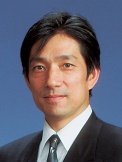Comprehensive List of Researchers "Information Knowledge"
Department of Systems and Social Informatics
- Name
- YASUDA, Takami
- Group
- Designing of Electronic Society Group
- Title
- Professor
- Degree
- Dr. of Engineering
- Research Field
- Chair of electronic society design / Media society / Socio Informatics

Current Research
Design of Electronic Society from Citizen Viewpoint
■Becoming a producer of the information society by designing an electronic societyHarmony between communication and broadcasting is in its infancy, although the Internet keeps growing and evolving as a global information infrastructure. Using both communication tools in broadcasting fields and broadcasting tools in communication fields, we expect additional emerging services that will change society and make it much more convenient.
Our research group's goal is to design and propose social systems by using Information Communication Technology (ICT) that emphasizes citizen aspects. We believe that people must become happy using ICT. Our research is approached from two directions : development of technology and applications in society. We would like to aid individuals become producers in the information society through research at the frontiers of liberal arts and science courses.
■For a peaceful and safe ubiquitous society
Community map making using WebGIS has been tried in various Internet regions. It is expected to contribute to community safety and activation as a vicinity map or vicinity extra. In order to achieve a peaceful and safe world, information must be shared about traffic accidents, high-crime zones, and shelters during disasters. Senior citizens who have resided in the region (vicinity wisdom bag) for many years might share their life experiences with the younger generation. They might also offer protection from disasters such as floods. It is possible to reduce the generation gap and reinvigorate senior citizens who can still contribute to the region. The residents particular sense of participation can seep through the community by this approach, offering a chance to induce relations by a virtual Internet space to merge with real society. Such Web tools as electronic bulletin boards, blogs, and Social Networking Service/Systems (SNS) can become effective means for community safety and activation in the information society.
■Electronic government/electronic municipality services from citizen aspects
When an administrative service is executed, an environment in which all people receive benefits should be in place. Therefore, infrastructure maintenance is necessary. However, people exist who cannot use information technologies, even if tools are maintained to promote electronic administrative services. Eradicating this"digital divide"is crucial to designing an electronic society. Social needs are also huge for the development of software that can easily send and receive e-mail and browse the Internet. Even senior citizens, the handicapped, the sick, and children can use the Internet with general personal computers and electrical appliances with such software. The current development and maintenance of hardware and software are insufficient to erase the actual digital divide. Relations with a person's community are indispensable to operate within a social system. This is the best theme on which it should work with industrial-government-academic cooperation. Moreover, another important field of research is administrative services that use new media including radio, car navigation systems, wireless cellular phones, ground wave digital television/LANs, etc. What administrative service best exploits the characteristics of each media in general times and in emergencies? Designing a system that can make public announcements during disasters is important.
■New education systems with ICT
Information education has been enhanced by compulsory education courses that have introduced the topic in high schools and academic training. Therefore, many teaching materials are available on the Internet, and practice and education reports are increasing, too. Moreover, digital teaching material related to the introduction of museums and owning goods and an exhibit is being offered by a museum. The verification and effectiveness of a coordinated system proposal that uses the ICT of study facilities, museums (including libraries), schools, and the home are expected to become an important theme in the future. In addition, an interesting field will study a new lifelong learning system of blended learning and Virtual Reality (VR). The construction of a library image as a"wisdom aggregator"in the ICT age is an interesting field. Happily discussing tai chi chuan using human body operation data with a motion capture device or healthy yoga movements with a remote friend at home through IP cameras/mikes are important aspects of the design of a basic healthy society.
Career
- 1987 : Completion of Nagoya University graduate school doctoral course (Information Engineering)
- 1987 : Research Associate in the Department of Information Engineering at Nagoya University. 1993 : Associate Professor in the School of Informatics and Sciences at Nagoya University. 2003 : Professor in the Graduate School of Information Science
Academic Societies
- The Institute of Electronics
- Information and Communication Engineers Information Processing Society of Japan
- The Japan Society for Socio-Information Studies
- Society for Art and Science
- Japan Information-Culturology Society
- The Japan Society of Information and Communication Research
- Digital Games Research Association JAPAN
Publications
- Y. NISHIO, T. YASUDA, and S. YOKOI : Design and Contents of a 3Dblog System and its Applications to Edutainment, Lecture Notes in Computer Science ISBN : 3-540-33423-8, Volume 3942/2006, pp. 552-565, (March 2006).
- M. ENDO, T. YASUDA, and S. YOKOI : A Distributed Multiuser Virtual Space System, IEEE Computer Graphics and Applications, Vol. 23, No. 1, pp. 50-57 (Jan. 2003).
- T. YASUDA, S. YOKOI, J. TORIWAKI, K. and INAGAKI : A Shading Model for Cloth Objects, IEEE Computer Graphics and Applications, Vol. 12, No. 6, pp. 15-24 (Nov. 1992)








